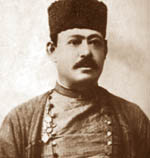
Sadigjan
Encyclopedia

Shusha
Shusha , also known as Shushi is a town in the disputed region of Nagorno-Karabakh in the South Caucasus. It has been under the control of the self-proclaimed Nagorno-Karabakh Republic since its capture in 1992 during the Nagorno-Karabakh War...
– 1902, Shusha
Shusha
Shusha , also known as Shushi is a town in the disputed region of Nagorno-Karabakh in the South Caucasus. It has been under the control of the self-proclaimed Nagorno-Karabakh Republic since its capture in 1992 during the Nagorno-Karabakh War...
), was an Azerbaijan
Azerbaijan
Azerbaijan , officially the Republic of Azerbaijan is the largest country in the Caucasus region of Eurasia. Located at the crossroads of Western Asia and Eastern Europe, it is bounded by the Caspian Sea to the east, Russia to the north, Georgia to the northwest, Armenia to the west, and Iran to...
i tar
Tar (lute)
The tār is a long-necked, waisted Iranian instrument. It has been adopted by other cultures and Azerbaijan. The word tar itself means "string" in Persian, though it might have the same meaning in languages influenced by Persian or any other branches of Iranian languages like Kurdish...
-player (sazanda
Sazanda
A sazanda or sazandar is one of the three musicians in the traditional ensemble of instrumentalists performing mugham along with a singer . The word means "builder" in Persian...
) known for developing the Azeri tar (or Caucasus tar or 11 string tar) from the Iranian tar.
Life and Fame
Sadigjan was born to a poor family of a watchman in ShushaShusha
Shusha , also known as Shushi is a town in the disputed region of Nagorno-Karabakh in the South Caucasus. It has been under the control of the self-proclaimed Nagorno-Karabakh Republic since its capture in 1992 during the Nagorno-Karabakh War...
. As a teenager, he took vocal lessons but lost his voice at the age of 18. He then took up pipe
Pipe (instrument)
Pipe describes a number of musical instruments, historically referring to perforated wind instruments. The word is an onomatopoeia, and comes from the tone which can resemble that of a bird chirping.-Folk pipe:...
, kamancheh
Kamancheh
The kamānche or kamāncha is a Persian bowed string instrument related to the bowed rebab, the historical ancestor of the kamancheh and also to the bowed lira of the Byzantine Empire, ancestor of the European violin family. The strings are played with a variable-tension bow: the word "kamancheh"...
and eventually tar
Tar (lute)
The tār is a long-necked, waisted Iranian instrument. It has been adopted by other cultures and Azerbaijan. The word tar itself means "string" in Persian, though it might have the same meaning in languages influenced by Persian or any other branches of Iranian languages like Kurdish...
. By his mid-20s he was already a well-known tar player in South Caucasus
South Caucasus
The South Caucasus is a geopolitical region located on the border of Eastern Europe and Southwest Asia also referred to as Transcaucasia, or The Trans-Caucasus...
and the neighbouring regions. In the 1890s he founded a musical ensemble which included prominent folk singers and musicians performing Azeri, Armenian and Georgian folk songs.
Developing the Azeri tar
During the early 1870s, Sadigjan used the traditional Persian tar to develop the new version of this instrument, which later became known as the Azeri tar or the Caucasus tar. The Persian tar has 6 steel strings in 3 double-courseCourse (music)
A course is a pair or more of adjacent strings tuned to unison or an octave and usually played together as if a single string. It may also refer to a single string normally played on its own on an instrument with other multi-string courses, for example the bass string on a nine string baroque...
s (the low one in octave
Octave
In music, an octave is the interval between one musical pitch and another with half or double its frequency. The octave relationship is a natural phenomenon that has been referred to as the "basic miracle of music", the use of which is "common in most musical systems"...
). The Azeri tar invented by Sadigjan has further one extra bass-string on the side, on a raised nut, and usually 2 double resonance strings via small metal nuts halfway the neck. All these strings are running next to the main strings over the bridge and are fixed to a string-holder and the edge of the body. Overall the Azeri tar has 11 strings and 17 tones.
Early tar players held the instrument to their knees. Sadigjan developed a new manner by reducing the size of the instrument, and for the first time presented the play on a tar nestled to the chest. The Azeri tar became a symbol of Azerbaijani music in the 20th century, and was also used by musicians in Iran
Iran
Iran , officially the Islamic Republic of Iran , is a country in Southern and Western Asia. The name "Iran" has been in use natively since the Sassanian era and came into use internationally in 1935, before which the country was known to the Western world as Persia...
.
A tar is depicted on the obverse
Obverse and reverse
Obverse and its opposite, reverse, refer to the two flat faces of coins and some other two-sided objects, including paper money, flags , seals, medals, drawings, old master prints and other works of art, and printed fabrics. In this usage, obverse means the front face of the object and reverse...
of the Azerbaijani 1 manat
Azerbaijani manat
The Manat is the currency of Azerbaijan. It is subdivided into 100 qəpik. The word manat is borrowed from "moneta" which is pronounced as "maneta"...
banknote issued in 2006.

